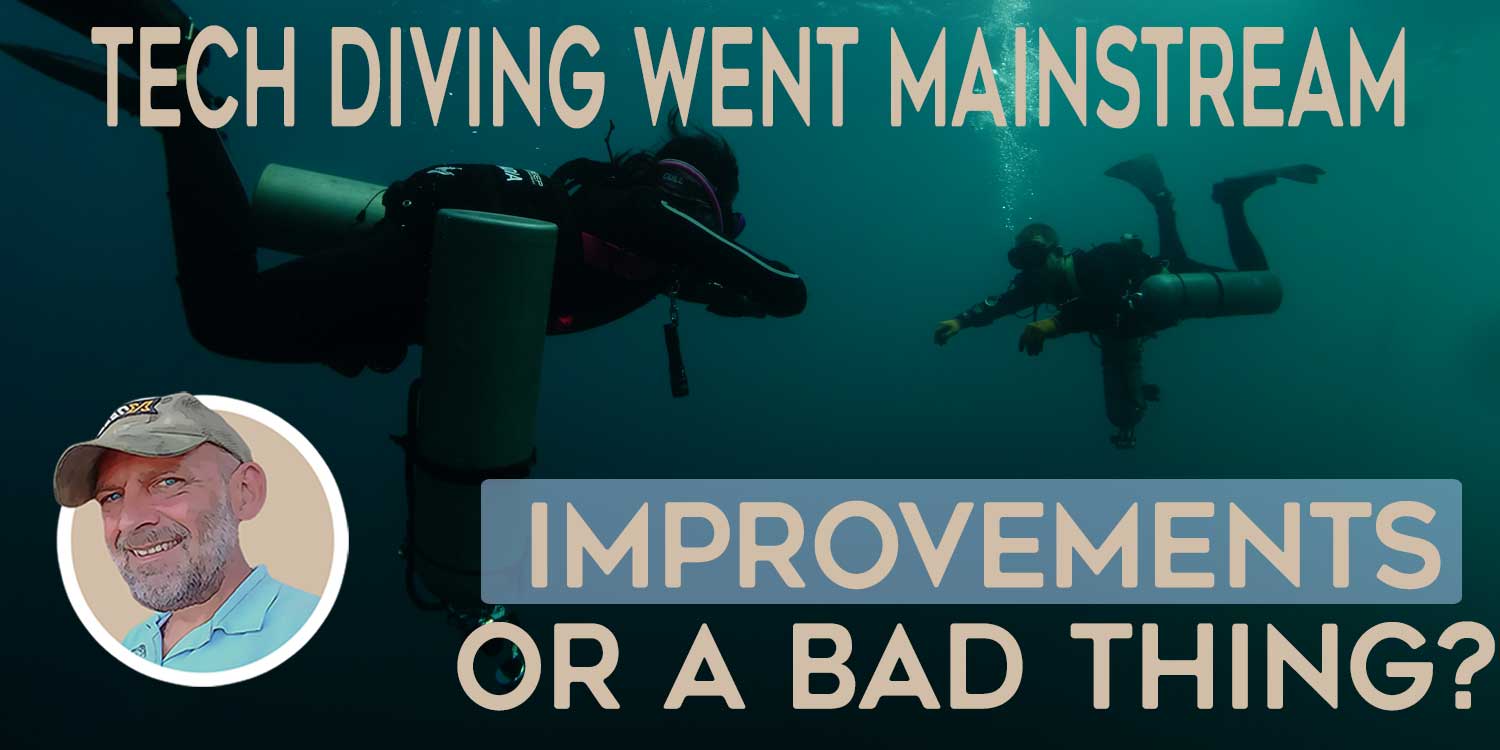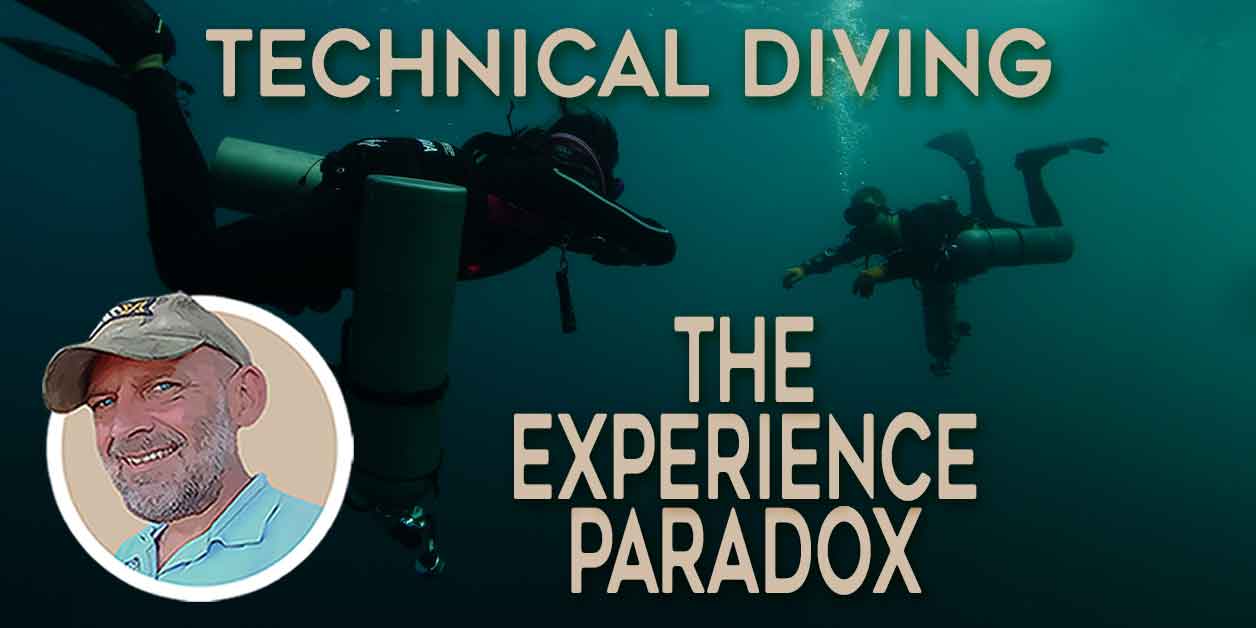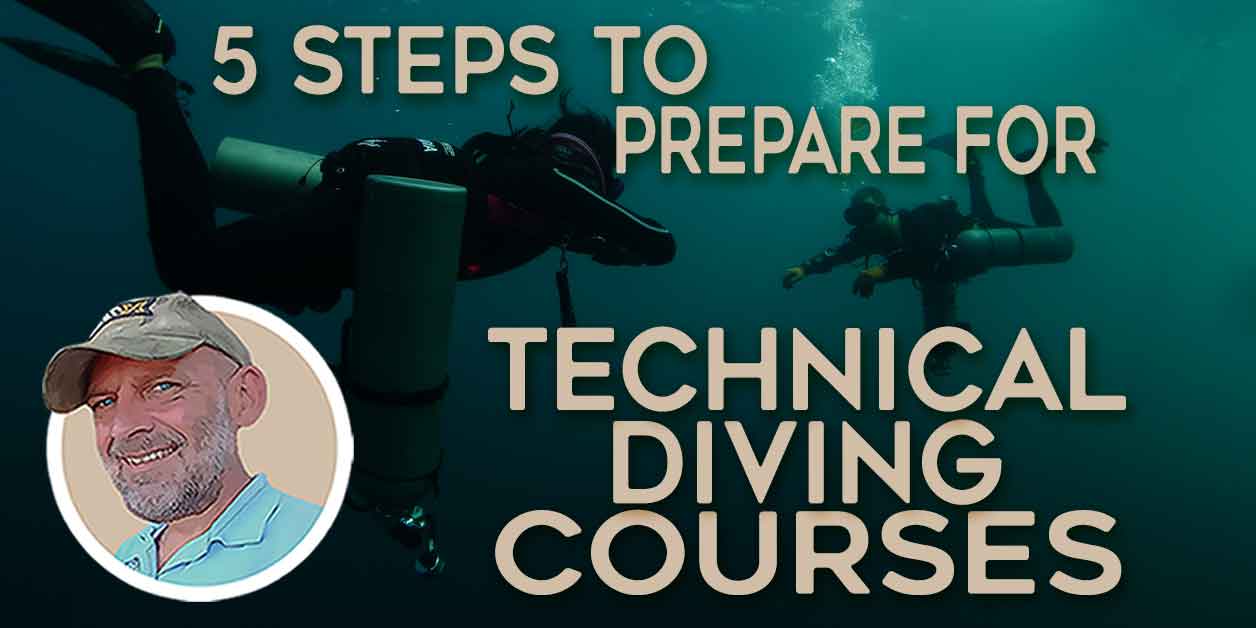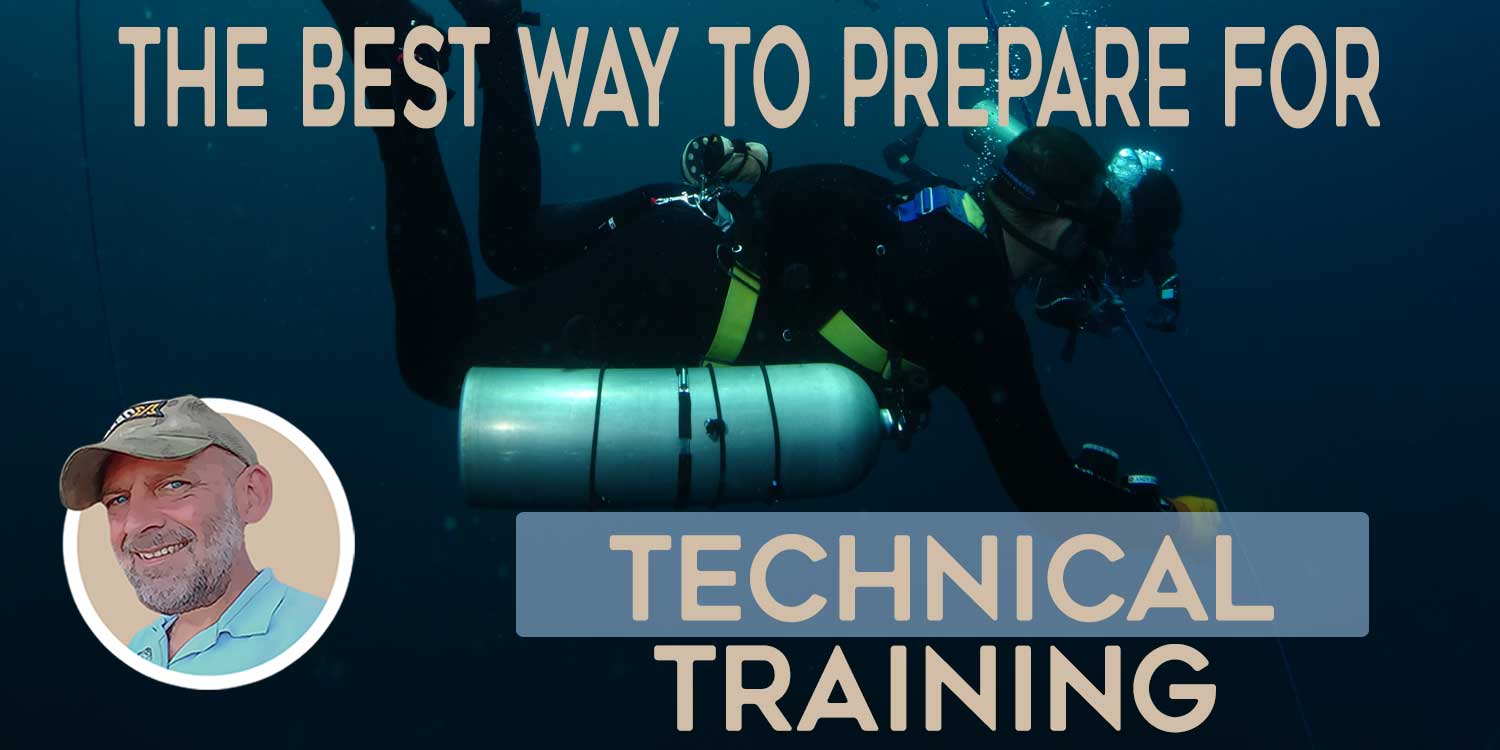What is Technical Diving?
Technical diving is a type of diving that goes beyond the limits of recreational diving. It involves diving at depths, for durations and/or in environments that require advanced training, equipment, and techniques, and it is typically performed by very experienced divers who have a high level of diving proficiency and competency.
Why Technical Diving is Different from Recreational Diving
Technical diving is different from recreational diving in several key ways. Firstly, technical diving involves diving to deeper depths, often beyond the limits of recreational diving, which is typically limited to a maximum depth of 130 feet / 40m.
Secondly, technical dives are often longer, lasting several hours, and require extensive mandatory decompression stops, which are planned pauses in the ascent to allow the diver’s body to off-gas excess nitrogen.
Thirdly, technical diving requires specialized equipment, including closed-circuit rebreathers, double cylinder systems, trimix (helium blend) and rich oxygen gas mixtures; several of which can be used on a single dive.
Lastly, technical diving utilizes more complex protocols, procedures and dive planning techniques than are taught and used in recreational-level diving.
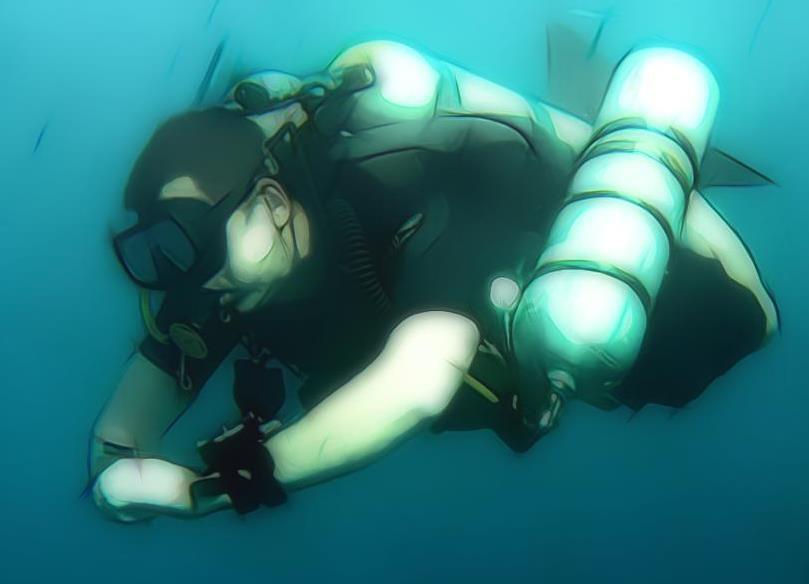
Access to the surface: a key factor
A key attribute of technical diving is that the diver is limited in their ability to ascend to the surface. This could be due to a physical overhead barrier such as a cave or wreck, or a virtual barrier (“glass ceiling”) created by the need to conduct mandatory decompression stops.
The inability to immediately ascend to the surface necessitates that the diver is planned, practiced, and equipped to deal with any problems they may encounter when underwater. As a consequence, very high attention to detail with risk management and mitigation defines responsible technical diving.
Specialized equipment is needed
Technical diving typically involves the use of specialized equipment such as twinsets, sidemount, closed circuit rebreathers (CCR), decompression, stage and/or bail-out cylinders, the addition of helium to breathing gasses, and utilizing a variety of gas mixtures over the course of a single dive.
More challenging training is necessary
Technical diving requires additional training to conduct more complex ascent profiles that are planned based on knowledge of modern decompression theory to optimize the off-gassing of nitrogen during incremental decompression stops.
Technical diving is a discipline that uses special methods, equipment, training and skills to improve underwater safety and performance, enabling divers to explore a wide range of underwater environments and perform tasks beyond the range of recreational diving. This typically involves ‘extended-range’ exposures outside the recreational envelope (no-stop dives in the 0-40m range) and is usually conducted in an ‘overhead environment’ of a wreck, cave or decompression ceiling where the diver cannot freely ascend to the surface
AquaCorp Magazine, 1991
The History of Technical Diving
The idea of “technical diving” first appeared in the cover story of the inaugural issue of “AquaCorps” magazine in 1990, titled “Call It High-Tech Diving.”
The article, written by diving physiologist Dr RW “Bill” Hamilton, described the then-current state of diving beyond the accepted conventional limits of depth, decompression, and mixed gas diving.
In issue 3 of Aquacorps, published in January 1991, the specific term “technical diving” was introduced by editor Michael Menduno; borrowing the terminology from the sport of ‘technical climbing’.
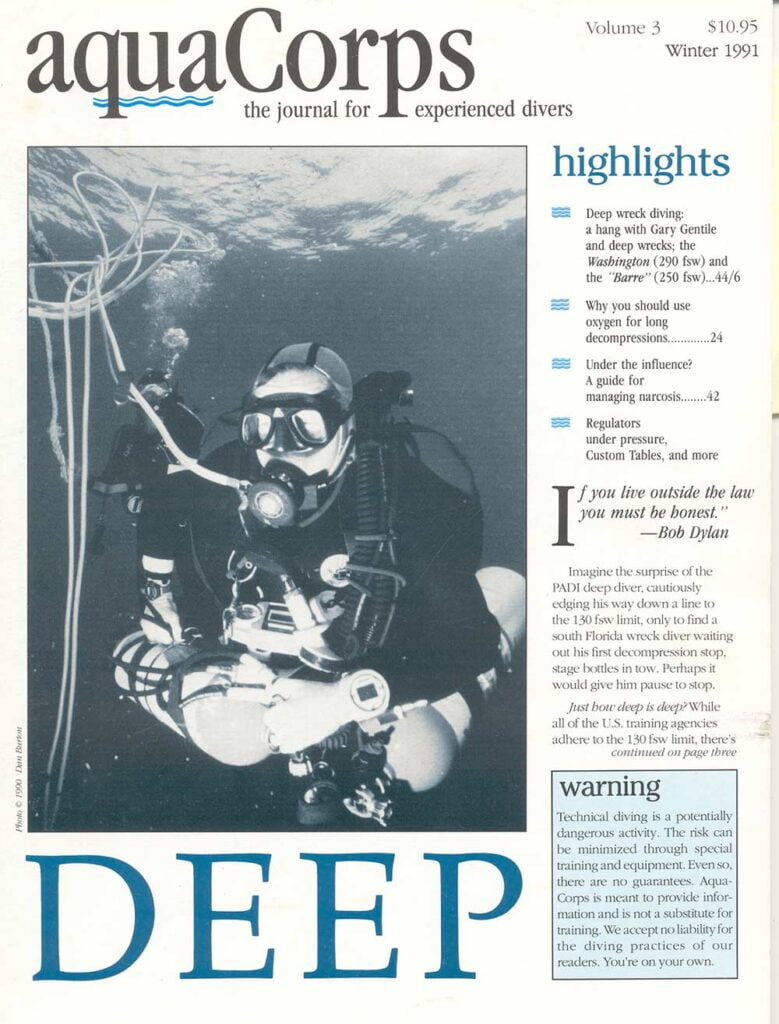
The motivation for extending the depth and duration of recreational diving was driven by the desire to explore inaccessible places.
The cave-diving community of the 1980s was particularly active in exploring the limits of air diving, with some doing relatively long air dives in the 60-125m depth range and doing decompression on oxygen. These experimental and dangerous dives were not disclosed to the public and there were no consensus guidelines for scuba diving beyond 40m.
The introduction of trimix to technical diving
The use of helium to offset narcosis and oxygen toxicity limits was introduced as a measure to make deeper diving safer. Military and commercial diving used trimix gases for decades, and that approach was adopted by early technical diving pioneers as early as the mid-1980s. At that time, explorers like Shek Exley were conducting mixed-gas cave dives as deep as 189-274m.
Initially, the use of helium for technical diving was informal within specific teams of divers, but technical training agencies began creating trimix certification courses in the early 1990s. Tom Mount introduced the first trimix qualification course through IANTD in 1991.
The Risks and Benefits of Technical Diving
Technical diving is not without its risks, and it is important for divers to understand the dangers and take the necessary precautions to minimize those risks. Some of the risks associated with technical diving include nitrogen narcosis, oxygen toxicity, and decompression sickness.
However, the benefits of technical diving are numerous, including the ability to explore deeper dive sites, experience longer and more complex dives, and develop a greater sense of personal satisfaction and achievement.
What are the Risks of Technical Diving?
Technical diving is inherently more dangerous than recreational diving due to the added complexity and potential for problems that can arise in challenging environments.
Divers must be well-trained and equipped to handle these risks, which include gas management problems, equipment malfunctions, and oxygen issues.
Nitrogen narcosis
Every scuba diver is taught that nitrogen narcosis becomes a factor at deep diving depths. It is often described using the analogy of alcohol intoxication; the “Martini Effect”. Sadly, that education is woefully out of date and, at best, only serves to suggest to divers that narcosis isn’t a problem they need to be overly concerned with.
The reality is that nitrogen narcosis is a sedative. It diminishes consciousness and cognitive ability. It rarely causes observable symptoms akin to intoxication. One of the first mental abilities to degrade when suffering from narcosis is the capacity to effectively self-diagnose your own cognitive performance. When you get marked, you lose the ability to realize you are impaired.
Nitrogen narcosis is also relatively slow in onset and persists when you ascend: a fact which I predict will contradict the advice on dealing with narcosis that you were taught in your diving courses.
Well-trained technical divers are taught to assume that narcosis is occurring, even if they don’t perceive it, and that it will significantly diminish their situational awareness, reasoning ability, skill performance, and ability to react appropriately in emergencies. To mitigate those risks, tech divers use trimix gas to manage the effect of nitrogen narcosis; substituting non-narcotic helium for nitrogen.
Different technical training agencies introduce trimix at differing levels with their technical diving programs; the contemporary general consensus is that an equivalent narcotic depth (END) of 100 feet/30m is ideal.
When do technical diving agencies introduce trimix?
Technical diving agencies have different policies on the introduction of helium. Early introduction of trimix training tends to reflect recognition of gas density, CO2 and nitrogen narcosis risks as a priority compared to keeping the cost and convenience of technical diving training at a minimum.
- GUE – Recreational Diver 3 course (END 30m)
- UTD – Recreational Diver 3 course (END 30m)
- RAID – Deco40 (END 30m) (also Deep Diver w/Trimix )
- IANTD – Recreational Trimix Diver (END 30m)
- TDI – Heliotrox Diver (45m)
- SSI – Extended Range Trimix (45m)
- ANDI – Technical Trimix (50m)
- PADI – Tec Trimix 65 (65m)
Gas density
The issue of gas density is willfully ignored by some mainstream recreational scuba training agencies; even though organizations like DAN have strong recommendations about the dangers it poses and how it should be limited. Their recommendations, supported by a scientific study run in conjunction with the US Navy, effectively limit diving on air to 31m (recommended) and 39m (absolute maximum).
As you know from basic scuba training, gas density increases as you dive deeper. There is a point where the gas density starts to decrease your respiratory efficiency. In short, the physics involved means your body rapidly diminishes the ability to expire CO2. Rapid hypercapnia and CO2 narcosis soon follow. This is dangerous in itself but added with the elevated exertion necessary in a diving emergency it, too frequently, leads to tragic outcomes.
As with nitrogen narcosis, technical diving agencies such as RAID, GUE and UTD are proactive in educating divers about gas density issues and implement the use of trimix early within the tech curriculum to mitigate that risk.
CO2 narcosis
CO2 narcosis is the most frequently encountered type of narcosis on deep dives. It is surprising that so little education is given about it in recreational diving courses. CO2 is 25 times more narcotic than nitrogen, is created inside your body and brain as part of the respiratory cycle and its physiological effect is, like nitrogen, a product of the gas partial pressure in your tissues; i.e. it increases in severity with depth.
Commonly nicknamed “dark narc”, CO2 narcosis typically presents with symptoms of increasing and inexplicable anxiety. That is often combined with the sensation of being unable to catch your breath and your head may feel like it is spinning. The anxiety grows quickly and, if unaddressed, can easily progress into an irrational panic.
Managing gas density through the use of trimix also has the benefit of moderating CO2 narcosis risk. That is coupled with a capacity to minimize exertion through effective skill practice and the development of psychological resilience through realistically challenging training and developing familiarization with stressor scenarios during tech courses.
Decompression sickness
The ticking clock of bottom time is another critical safety factor that a technical diver must remain aware of during their dive. Because nitrogen absorption occurs increasingly quicker at deeper depths it takes much longer to release that gas as the diver ascends.
If the technical diver surfaces with an excessive pressure of nitrogen remaining dissolved within their body, the gas will form into bubbles. Those bubbles will cause damage depending upon where they occur or travel to within the body. In the joints or spine, they will cause extreme pain when they impinge upon nerves. they can cause organ failure, damage to the vascular system, or respiratory distress. If bubbles get into the brain they will cause neurological damage.
Any delay that causes a technical diver to overstay on the bottom necessitates ever longer decompression stops before surfacing. Those stops can only be completed if the diver has a sufficient gas supply. Also, any emergencies occurring on the dive that lead to rapid ascents will be far less forgiving and far more likely to result in severe or fatal cases of the bends.
Hyperoxia
Hyperoxia occurs when the oxygen concentration in your breathing mix becomes too high, leading to oxygen toxicity. This can cause convulsions and unconsciousness; which typically lead to drowning when underwater.
Technical diving courses teach divers how to calculate a Maximum Operating Depth (MOD) appropriate for the oxygen content of their breathing gas mixture. Technical rebreather divers have a significant risk of hyperoxia if their CCR unit malfunctions; training courses cover the safety protocols and procedures to manage that risk is great detail.
Hypoxia
Hypoxia is a condition that occurs when your body doesn’t receive enough oxygen. This is primarily a risk when diving closed circuit rebreathers (CCR) or when conducting hypoxic trimix diving where the bottom gas has a reduced fraction of oxygen below what is necessary to support consciousness.
As with hyperoxia, technical and rebreather training courses ensure that effective risk mitigation protocols and procedures are learned to greatly minimize the likelihood of these hypoxic accidents occurring.
The Benefits of Technical Diving
If the increased risks are properly mitigated, technical diving offers a unique and exhilarating experience that is not possible with recreational diving.
Exploring otherwise inaccessible sites
Technical divers have the opportunity to explore a much wider range of sites and see things that a recreational-level diver never will. Removing the boundaries of no-decompression limits and maximum depths is enormously liberating for those who wish to become legitimate explorers of the unknown.
Challenge
Many technical divers enjoy the personal challenge that comes with tech diving. Both the training courses and the conduct of technical dives demand a high degree of commitment, investment, and effort. In short, the most satisfying experiences are not those that come easily and conveniently. Technical diving is the antithesis of a superficial instant gratification culture.
Complexity
The ‘technical’ aspect of tech diving is also a popular appeal for those who enjoy tinkering with and refining their equipment, designing operating protocols, or immersing themselves in the complexities of decompression theory. Whether a diver enjoys practical, procedural, or academic complexity, technical diving offers them a huge scope of involvement.
Community
Technical diving has a very active community and certification as a technical diver opens the door to participation and socializing with a like-minded crowd of active, high-competency, divers.
Because technical divers tend to be more active and invested in scuba diving, the tech community offers participants many opportunities to share knowledge, discuss techniques, share philosophies, talk about their explorations, debate tech diving gear and learn from the expertise and experience of others.
How to Get Started with Technical Diving
To get started with technical diving, it is important to seek out training and certification from a reputable technical diving organization. This will ensure that you have the knowledge and skills necessary to dive safely and responsibly.
Additionally, it is important to work with a dive center or instructor who has experience and expertise in technical diving, so that you can get the most out of your diving experience.
The Training and Certification Requirements for Technical Diving
Technical diving is not for the faint of heart. It requires advanced training and certification from recognized organizations, such as RAID, GUE, UTD, IANTD, and TDI. Technical diving courses typically include extensive classroom study, long sessions of shallow water skills development, and a progressively more challenging sequence of training dives.
Tech diving theory covers topics such as dive planning, gas management, decompression theory, and emergency procedures. Technical diving courses are substantially more challenging than recreational-level diving; failure rates are higher when students have not prepared themselves effectively for training.
The Benefits of Advanced Training in Technical Diving
Completing advanced training in technical diving can provide a number of benefits, including the ability to dive deeper, longer, and in more challenging environments. Advanced training can also help divers develop a deeper understanding of dive physics and physiology, as well as the skills necessary to manage complex dive plans and emergency situations.
How to Choose a Technical Diving School
When looking for a technical diving school, it is most important to consider the individual instructor who will be teaching the course. The more expert and experienced your instructor, the more likelihood you will have of passing the course at a high standard of proficiency.
Research prospective technical diving instructors diligently so that you do not waste money on incompetent training or put yourself at risk once certified as a technical diver. Use social media to engage with the technical diving community for recommendations of high-quality instructors.
The article below lists important considerations and steps to take when investigating potential technical diving course providers:
What are the technical diving training agencies?
There are several international organizations that offer technical diver training, including TDI, GUE, IANTD and PADI TecRec.
RAID
Rebreather Association of International Divers (RAID) is the world’s fastest-growing technical diving training organization and the first to offer a complete range of eLearning academic programs for divers, from beginner to instructor examiner levels, across recreational and technical diving, CCR, and freediving. RAID claims to have the most advanced internet training model in the industry, with over 60 programs available online.
Founded by Barry Coleman in 2007, RAID started as a dive training organization for the Poseidon Mk VI Discovery Rebreather and has since expanded to include open-circuit scuba training and programs for recreational and technical diving.
RAID is dedicated to a “begin with the end in mind” approach, providing students with training that consistently prepares them for higher levels.
The agency places a strong emphasis on training quality, and its performance standards are specific and measurable. RAID provides fundamental skills training that exceeds industry standards and promotes a “Do It Right” mindset.
TDI
Technical Diving International (TDI) is an American organization founded in 1994. It has a strong presence worldwide and starting on the technical diving program requires an Advanced Open Water certification from any organization, Nitrox certification, and a minimum of 25 dives.
The first technical courses offered are the Advanced Nitrox and Decompression Procedures, which allow diving to 45m with oxygen mixes up to 100% and staged decompression stops. The courses cover both theory and practical pool work and require at least 6 open-water dives for safe and efficient completion.
GUE
Global Underwater Explorers (GUE) is a worldwide network of communities driven by advanced diver training programs. With a focus on exploring and preserving aquatic environments, GUE is a pioneer in scuba education.
The organization boasts a team of highly skilled professional instructors who have created several industry-first training protocols, resulting in divers of exceptional caliber. The GUE-trained diver community spans the globe, providing not only social support but also access to a diverse range of underwater projects.
Unlike most commercial dive training organizations, GUE is a 501(c)(3) nonprofit company and is heavily involved in conservation initiatives and exploration missions to document new ocean and cave sites.
GUE established the principle of Doing It Right (DIR); a holistic approach to scuba diving that encompasses several essential elements, including fundamental diving skills, teamwork, physical fitness, and streamlined and minimalistic equipment configurations.
The training program begins with the Fundamentals course, which requires a tech-level pass before the diver can enroll on Tech Diver Level 1. This course allows diving to 51m with Trimix gas beyond 30m and is followed by Tech Diver Level 2 to a depth of 75m. GUE also offers courses in rebreather and cave diving.
UTD
Unified Team Diving (UTD) is another “DIR” philosophy agency. The foundations of Unified Team Diving’s ideology and values can be traced back to the minimalist Hogarthian/DIR system and its principles. In 2008, UTD chose to take a different approach and embrace the concept of customization.
Building on its roots in Hogarthian and DIR diving, UTD evolved a system for the “unification” of equipment configuration protocols and procedures.
Their aim was to maintain the standardization and minimalist approach of DIR with open-circuit back-mount but expand the “tool set” to include side-mount and closed-circuit rebreather diving. The three configuration systems were developed into one unified, consistent, scalable, and interchangeable approach while maintaining the minimalist mindset. As a result, UTD favors seamless “mixed” team diving.
IANTD
The International Association of Nitrox and Technical Divers (IANTD) is a founding technical dive training agency; has been operating for over 30 years. They have been pioneering the field since the inception of the first nitrox course and technical diving programs.
The IANTD syllabus encompasses a wide range of training courses, from Open Water Diver to Expedition Trimix, using both open and closed-circuit diving equipment and cave diving programs. The training programs are designed to equip divers with the essential skills and knowledge necessary to become confident, responsible, and self-sufficient divers, both mentally and physically.
PADI TecRec
TecRec is the technical diving division of the largest recreational training agency: PADI.
The first step is the Tec40 certification, which requires Advanced Open Wate, Deep Diver, and Nitrox certification, along with a minimum of 10 logged nitrox dives. Tec40 allows diving to 40m with limited decompression using gas mixes up to 50% oxygen.
The Tec40 course is a prerequisite for the Tec45, which allows unlimited decompression if carefully planned, and the Tec 50, which increases the allowable depth to 50m. Further training is available with Tec65 (normoxic trimix) and Tec90 (full trimix) certification courses.
The Importance of Equipment in Technical Diving
Having the right equipment is crucial for a successful and safe technical dive. Technical diving gear is more complex and comprehensive than what recreational divers use because it has to ensure that the diver can survive any foreseeable failures without immediately surfacing.
It also has to cater to more complex dive profiles that include switching between different gas mixtures and facilitate calculating and completing a series of decompression stops on the way to the surface.
The 3 Primary Equipment Configurations for Technical Diving
Technical divers primarily use three different equipment configuration systems; twin-sets, sidemount, or closed circuit rebreathers (CCR).
Twin-sets / Doubles
Twin-sets, also known as “doubles”, consist of two cylinders worn on the back which are connected via an isolating manifold. This configuration allows the diver to access both tanks via either regulator whilst simultaneously allowing them to shut off any component that fails.
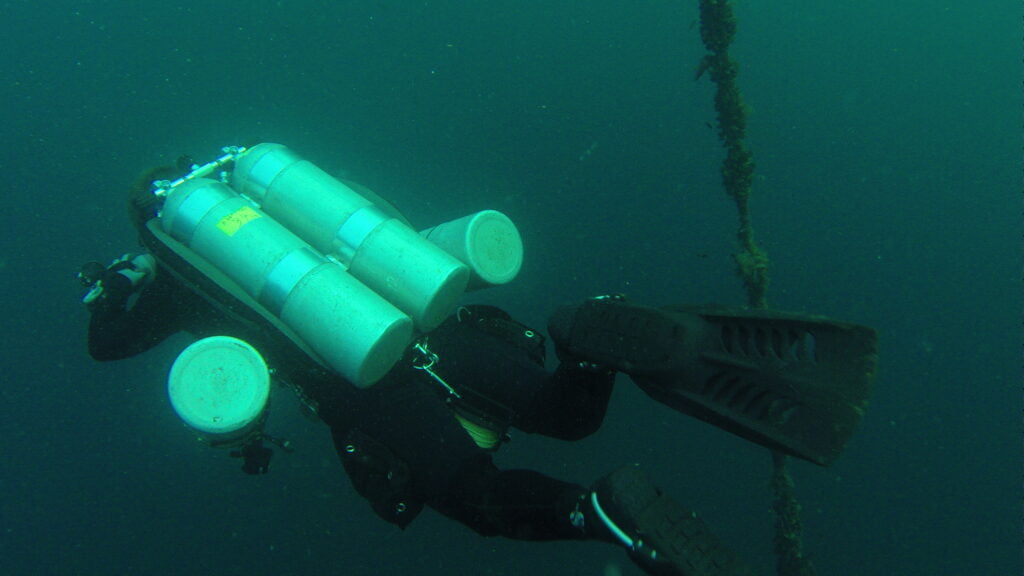
Sidemount
Sidemount gear allows technical divers a more streamlined and flexible configuration. The cylinders are clipped onto the side of the diver and held snugly by elastic bungees.
This equipment is a lot less bulky and heavy for traveling and can allow the diver to explore beyond tightly confined spaces where a twin-set would not fit. Being able to pass through restrictions makes sidemount very appealing to cave and wreck exploration divers.
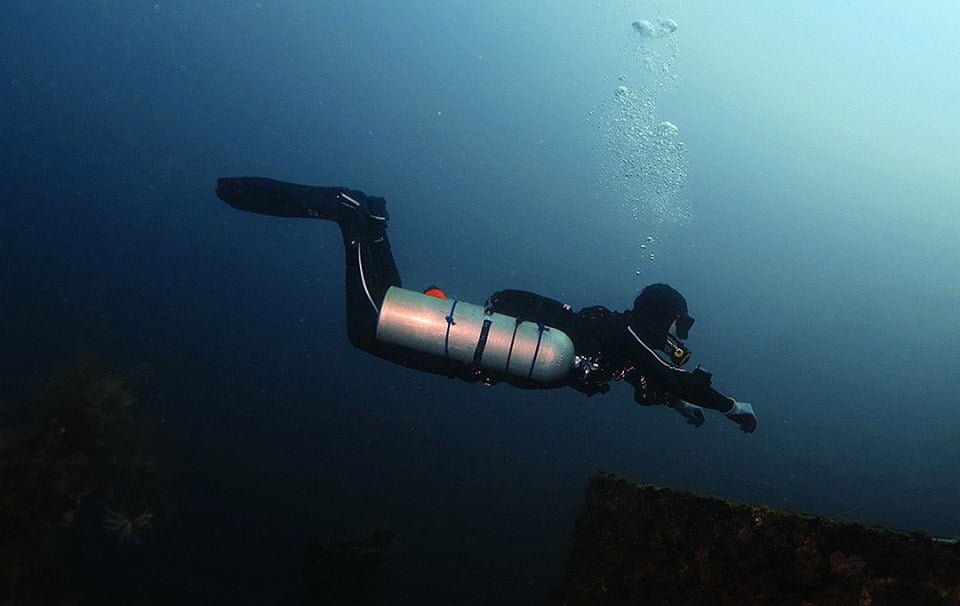
Closed Circuit Rebreathers (CCR)
CCRs recycle a diver’s exhaled gas by removing exhaled CO2 and replenishing the oxygen content of the breathing gas. They are the preferred method for deep dives as they use the gas supply far more efficiently and minimize the amount of decompression needed to be done.
Inside a CCR, exhaled gas passes through a canister filled with a chemical called Sofnolime (known as a “scrubber”) to remove CO2 before traveling into a counter-lung. Within the counter-lung, oxygen is added to the mixture to replenish what the diver has already metabolized.
Electronic CCR (eCCR) controls the oxygen content automatically via computer, whilst Manual CCR (mCRR) requires the diver to monitor oxygen levels and add more oxygen as it is required. When the diver inhales, gas is drawn from the counter-lungs. The process is a continual loop and nitrogen and helium, not being involved with metabolization, is not wasted.
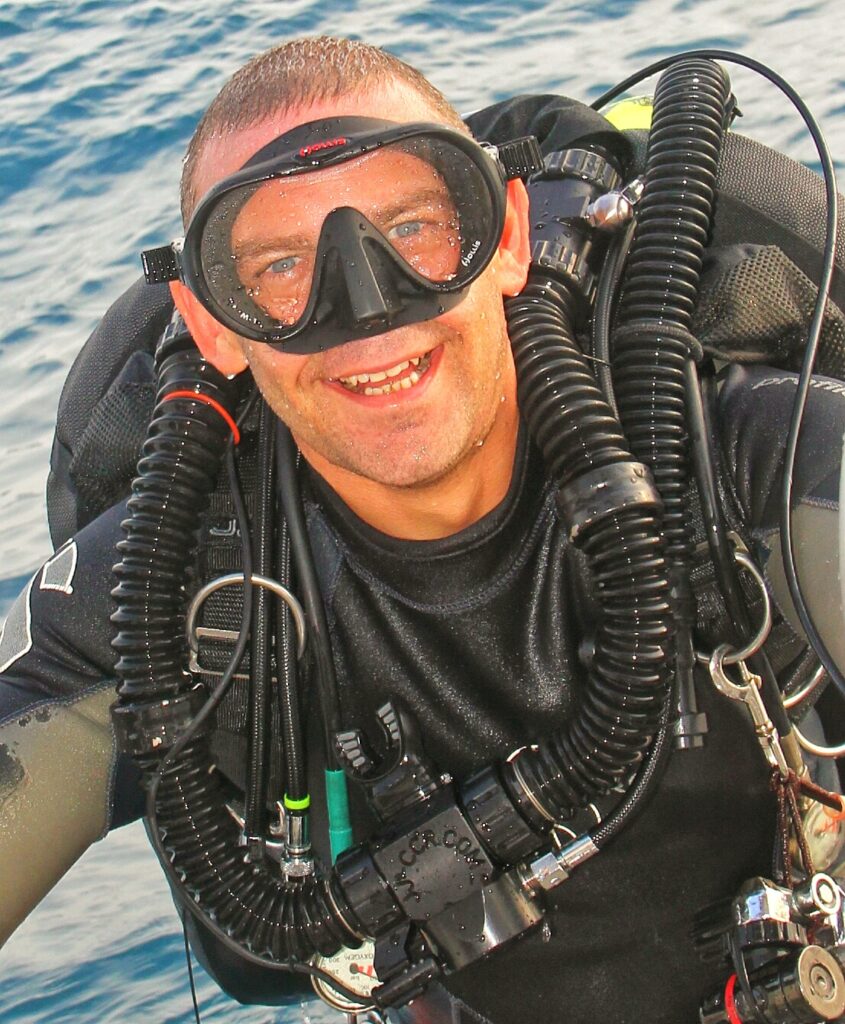
Equipment Redundancy
Because technical divers have to resolve every foreseeable issue or incident without being able to directly ascend to the surface, it is vital that critical life-support and dive management equipment is redundant. In short, if a dive cannot be safely completed should the equipment fail, then the technical diver will carry a spare. Equipment that is typically redundant includes:
- Regulators
- Primary gas cylinders
- Diving computers
- Delayed Surface Marker Buoys (DSMB) and spools/reels
- Masks
- Cutting devices
Equipment Simplicity and Minimalization
Technical diving is complex and that places a large cognitive demand on the diver. Keeping tech diving gear as simple and clean as possible helps lower that cognitive demand and improve diver performance. Most technical diving instructors advocate a “K.I.S.S” (keep it super simple) approach to technical diving gear.
Technical diving equipment minimalization also recognizes a principle of “failure points”. Put simply, the more points of potential failure exist on a technical divers gear, the more chance for a failure to occur. Prudent technical divers seek to identify failure points in their gear and eliminate them if the gear isn’t strictly necessary or a less complex alternative exists.
Understanding Dive Planning and Gas Management
Technical diving requires careful planning and a thorough understanding of dive physics, physiology, and gas management. Dive planning includes choosing the right dive site, selecting the appropriate dive plan, and determining the necessary equipment and decompression schedule.
Gas management is a critical component of technical diving and involves carefully calculating and monitoring the use of different gases during the dive. Tech divers may use multiple gas sources, such as air, nitrox, and trimix, to help manage decompression and ensure a safe ascent to the surface.
Technical Diving Gas Mixtures
Technical divers must use appropriate gas mixtures depending on the depth they are diving at. The following types of gas are used in technical diving:
Types of Gas Used in Technical Diving
- Bottom gas: the gas mixture planned for the deepest part of the dive.
- Travel gas: a gas mixture used to travel from the surface to the depth where a hypoxic bottom gas can be safely breathed.
- Deco gas: a gas mixture rich in oxygen to accelerate decompression.
- Trimix: a gas mixture containing helium (oxygen and nitrogen)
- Hypoxic trimix: a trimix blend with less than 18% oxygen
- Normoxic trimix: a trimix blend with 18-21% oxygen
- Heliox: a blend of helium and oxygen (no nitrogen)
The factors dictating an ideal gas mixture are:
Oxygen Partial Pressure
The maximum partial pressure of oxygen (ppO2) for a bottom gas is 1.4, which can be achieved using air at a depth of 184 feet / 56m. Beyond that depth, a fraction of oxygen must be replaced with helium to moderate the ppO2.
When conducting decompression, technical divers will accelerate their stops by using richer oxygen mixtures. In this instance, it is common to increase the ppO2 to a maximum of 1.6. The most common decompression gas mixes are 50%, 80%, and/or 100% O2.
Gas Density
Following scientific studies, DAN recommends an ideal maximum gas density of 5.2 g/L and an absolute maximum of 6.2 g/L. Some agencies respect that guidance and teach technical divers to add helium to breathing gasses as a way to reduce gas density.
Air has a weight of 1.293 g/L per atmosphere. A simple calculation shows that the DAN recommended ideal gas density limit is reached at a depth of 102 feet / 31m. Helium only has a weight of 0.179 g/L per atmosphere compared to nitrogen which is 1.251 g/L.
Narcosis Management
Because technical diving is more complex to perform and the consequences of mistakes are far more severe, gas mixtures are calculated to manage the narcosis that a technical diver is subjected to.
Helium, a very low narcotic gas, can be used to replace nitrogen which is far more narcotic under relatively little additional pressure.
Technical divers use an Equivalent Narcotic Depth (END) formula to determine how much helium must be added to a gas mix to enable a predetermined level of narcosis effect. Whilst this may sound complicated, it is not more difficult than the equivalent depth formula learned in recreational nitrox courses.
Decompression Procedures and Stops
Decompression is an important aspect of technical diving, as it helps prevent decompression sickness and allows for a safe and efficient ascent to the surface.
Deco procedures involve multiple decompression stops, during which the diver pauses at specific depths to allow for the gradual release of dissolved nitrogen in their body and switching to richer oxygen blend breathing gasses to increase the efficiency of inert gas elimination.
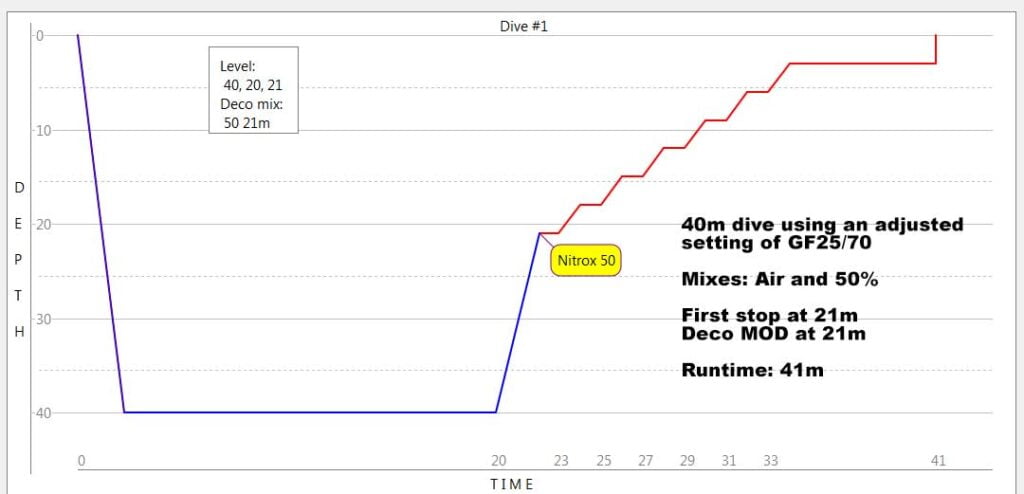
Technical divers plan their decompression profiles using technical diving computers or dedicated laptop/desktop software like Multideco
The article linked below gives an illustration of one method for calculating decompression profiles in technical diving:
The Future of Technical Diving
Technical diving continues to evolve, with new technologies and techniques being developed all the time. As diving equipment and training programs continue to improve, the opportunities for technical divers to explore new and challenging dive environments will continue to expand.
The use of close circuit rebreathers is becoming ever more popular; especially as they are very cost-effective in reducing helium costs when trimix diving. A CCR, along with the necessary training, can recoup its cost within a few dozen dives by substantially reducing the volume of helium that a diver consumes on a technical dive.
Technical diving has grown greatly in popularity over the last 1-2 decades, but this has created unique problems. In some instances, training agencies and instructors have leaped to capitalize on the appeal of technical diving to increase their revenues. This has led to some dilution in the level of expertise at which technical diving training is delivered; newly qualified tech instructors may be far less experienced and the performance standards to certify in technical diving courses have declined in some cases. Read more in this article:
Books About Technical Diving
To learn more about technical diving, you should consider reading one or more of these excellent books:
Here is my in-depth review of favorite technical diving books…
Conclusion
Technical diving is a type of diving that requires advanced training and equipment, and it is performed by experienced divers who have a high level of proficiency in diving skills.
It offers divers the opportunity to explore deeper and more remote dive sites, experience longer and more complex dives, and develop a greater sense of personal satisfaction and achievement.
While it is not without its risks, technical diving is an exciting and rapidly evolving discipline that is likely to continue to grow in popularity in the years to come.
About The Author

Andy Davis is a RAID, PADI TecRec, ANDI, BSAC, and SSI-qualified independent technical diving instructor who specializes in teaching sidemount, trimix, and advanced wreck diving courses.
Currently residing in Subic Bay, Philippines; he has amassed more than 10,000 open-circuit and CCR dives over three decades of challenging diving across the globe.
Andy has published numerous diving magazine articles and designed advanced certification courses for several dive training agencies, He regularly tests and reviews new dive gear for scuba equipment manufacturers. Andy is currently writing a series of advanced diving books and creating a range of tech diving clothing and accessories.
Prior to becoming a professional technical diving educator in 2006, Andy was a commissioned officer in the Royal Air Force and has served in Iraq, Afghanistan, Belize, and Cyprus.
In 2023, Andy was named in the “Who’s Who of Sidemount” list by GUE InDepth Magazine.
Purchase my exclusive diving ebooks!
Technical Diving FAQs
The maximum depth for technical diving is only limited by physiological factors. Full Trimix courses are typically the deepest training that agencies offer; with a maximum training dive depth of 330 feet/ 100m. Progression beyond maximum training depths is possible after certification as the diver acquires further experience and proficiency. The deepest technical dive on record was conducted by Ahmed Gabr to 1090 feet / 332m in 2014.
Yes, technical diving typically requires specialized equipment, including twin-sets, sidemount, CCR, decompression cylinders, and technical diving computers, to manage the increased risks and complexities of these dives.
The length of time to become certified in tech diving varies depending on the diving organization and the specific level of course. Courses typically involve classroom study, shallow skills practice, and a series of progressively more challenging dives. Courses vary in duration between two days and a week.
Technical diving does carry increased risks compared to recreational diving, such as oxygen toxicity, hypoxia, narcosis, and decompression sickness. However, these risks can be minimized through proper training, equipment, and dive planning.
The future of tech diving is promising, as technology improves and diving equipment becomes more advanced, accessibility to technical diving will increase. More divers will be able to explore deeper dive sites and overhead environments like caves and wrecks. The popularity of technical diving has been increasing over recent decades and that trend is likely to continue to grow in the years to come.
Tech diving typically involves deeper dives, no immediate/direct access to the surface, the use of multiple gas sources, as well as specialized equipment, whereas recreational diving is typically limited to depths of 130 feet / 30m or less, does not require the use of multiple gas sources or permit mandatory decompression.
Yes, the cost of technical diving equipment is generally much higher than that of recreational diving equipment, but the investment is often well worth it for experienced divers who want to explore a wider variety of deeper dive sites.
Originally posted 2023-02-08 21:31:15.







